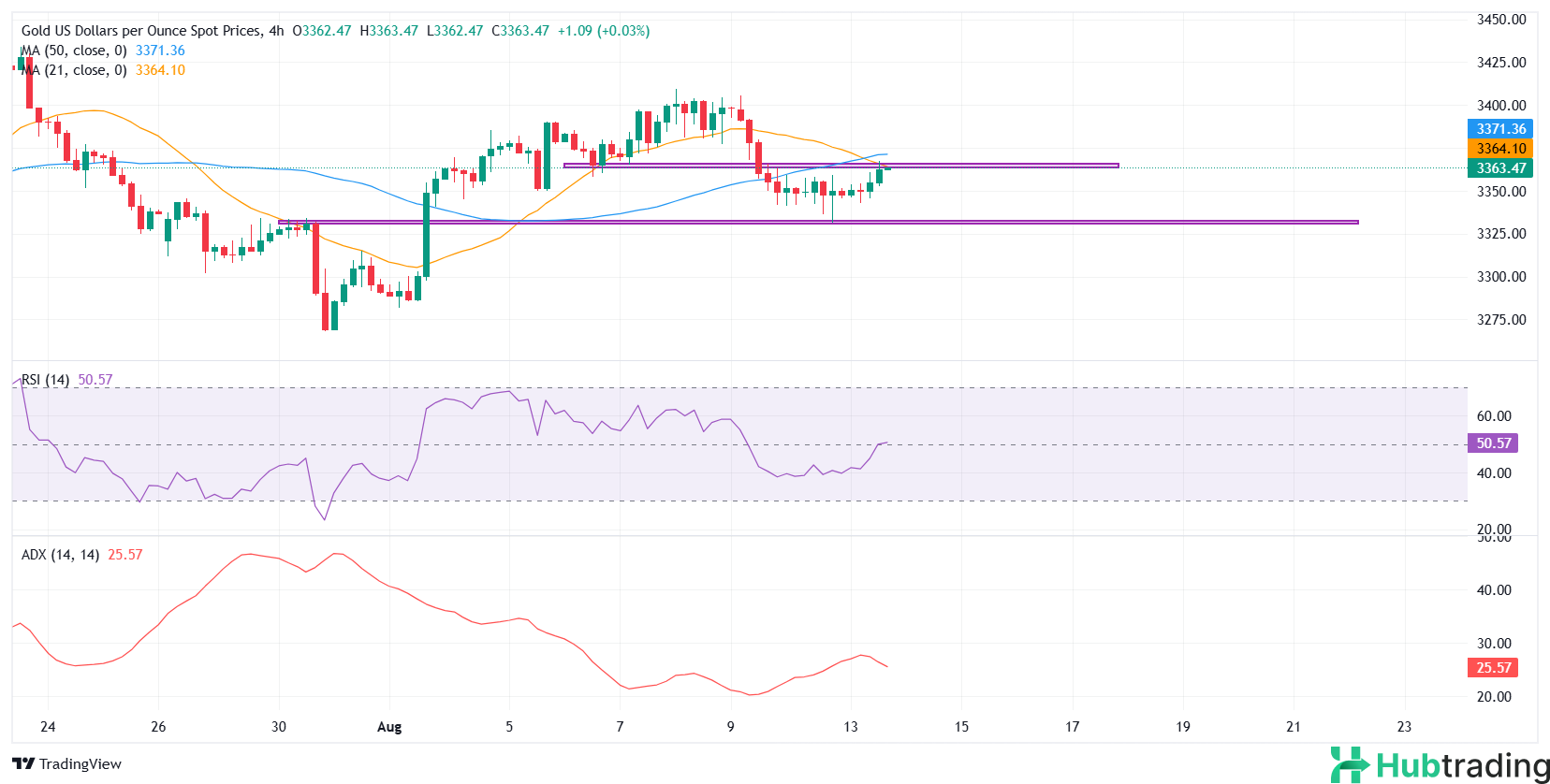Gold (XAU/USD) is consolidating just above $3,350 in the American session, up 0.25%, after paring gains from an earlier peak near $3,370. The metal remains underpinned by a weaker US Dollar, following fresh US inflation data that bolstered expectations of a Federal Reserve interest rate cut at its September 16–17 meeting.
July’s Consumer Price Index (CPI) report showed headline inflation rising in line with monthly forecasts, while the annual rate dipped slightly below expectations. However, the core CPI — which excludes food and energy — came in marginally above projections on both a monthly and yearly basis, highlighting persistent underlying inflation.
Despite the mixed data, markets reacted positively, viewing the report as a sign that inflation is not accelerating rapidly, even amid new tariffs. This, along with signs of a cooling labor market, further cemented expectations of a Fed rate cut. The CME FedWatch Tool now indicates a greater than 95% chance of a 25 basis point reduction next month.
The US Dollar fell broadly in response, offering additional support to Gold.
While investor sentiment remains upbeat, with global equities hovering near record highs, optimism around a 90-day pause in additional US-China tariffs and anticipation ahead of Friday’s US-Russia peace talks in Alaska could limit Gold’s upside, as risk-on mood tempers safe-haven demand.
Market Movers: Soft Inflation and Fed-Trump Tensions Shape Market Mood
- US inflation data and rising political tensions are steering market sentiment midweek. July’s headline Consumer Price Index (CPI) rose 0.2% month-over-month, in line with forecasts, following a 0.3% increase in June. On an annual basis, inflation slowed slightly to 2.7%, below expectations of 2.8%. However, core CPI — which strips out food and energy — accelerated, climbing 0.3% MoM and 3.1% YoY, both above prior readings and market forecasts, pointing to persistent underlying inflation.
- The US Dollar Index (DXY) extended its decline for a second straight day, dropping to 97.70 — its lowest in over two weeks — as traders ramped up bets on a Federal Reserve rate cut in September, with markets also pricing in a second reduction before the end of the year.
- Year-to-date, the US Dollar has shed over 10% amid growing fiscal concerns and ongoing tariff tensions. A new Treasury report revealed the national debt has topped $37 trillion for the first time, while recent legislation signed by President Trump is expected to add an additional $4.1 trillion over the next decade, further straining investor confidence in the Greenback.
- Bond yields moved lower, with the 10-year Treasury yield falling toward 4.235% and the 30-year near 4.825%, as markets grow more confident in a renewed easing cycle by the Fed.
- Equity markets remained resilient, with US stocks extending gains. The S&P 500 and Nasdaq 100 added about 0.3% each, notching new all-time highs, while the Dow Jones surged over 300 points.
- Meanwhile, political tensions added a fresh layer of uncertainty. Treasury Secretary Scott Bessent warned that the US could impose further sanctions or secondary tariffs if upcoming peace talks between President Trump and Russian President Vladimir Putin fail. In a separate interview, Bessent also pushed for aggressive rate cuts, suggesting the Fed should lower interest rates by 150–175 basis points, including a 50 bps cut in September.
- President Trump also reignited criticism of Fed Chair Jerome Powell, posting on Truth Social that he is considering greenlighting a lawsuit against Powell, accusing him of gross mismanagement. These comments raise further concerns over the Fed’s independence and add political risk to the markets.
- Adding to the drama, Trump nominated E.J. Antoni, a well-known critic of federal employment data, to head the Bureau of Labor Statistics following the dismissal of Erika McEntarfer after July’s disappointing jobs report. Antoni has advocated for shifting from monthly to quarterly jobs reports, which could significantly alter how labor data is analyzed and acted upon.
- Despite stubborn inflation, the Fed is also facing increasing pressure from the labor side of its dual mandate. Hiring momentum has weakened noticeably in recent months, increasing the case for monetary easing.
Technical Analysis: Gold (XAU/USD) Holds Steady Above $3,350 as Bulls Look for a Breakout

Gold is trading near $3,360 in the US session, consolidating recent gains within a tight range. The $3,360–$3,370 zone has emerged as a key resistance area, coinciding with the 21-period Simple Moving Average (SMA) at $3,365 and the 50-period SMA at $3,371. This confluence makes it a pivotal level for bulls to clear.
Price action reveals multiple lower wicks in recent candles, reflecting buying interest on dips. However, Gold remains largely range-bound between $3,330 and $3,360, awaiting a decisive breakout.
A clear move above the $3,370 level could open the door for a test of $3,380, with the next target at the psychological $3,400 mark. Conversely, a failure to break above may lead to renewed consolidation or a retest of $3,330. A drop below that support would expose $3,300 as the next downside level.
Momentum indicators reflect market indecision. The 14-day Relative Strength Index (RSI) sits near the neutral 50 mark at 48.82, while the Average Directional Index (ADX) at 26.49 suggests moderate trend strength without a clear directional bias. A fresh catalyst — likely from macroeconomic data or geopolitical developments — may be needed to drive the next significant move.





